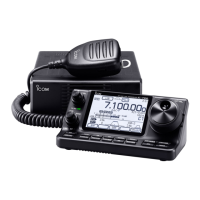For amateur base station installations it is recom-
mended that the forward clearance in front of the an-
tenna array is calculated relative to the EIRP (Effective
Isotropic Radiated Power). The clearance height below
the antenna array can be determined in most cases
from the RF power at the antenna input terminals.
As different exposure limits have been recommended
for different frequencies, a relative table shows a guide-
line for installation considerations.
Below 30 MHz, the recommended limits are specified
in terms of V/m or A/m fields as they are likely to fall
within the near-field region. Similarly, the antennas may
be physically short in terms of electrical length and that
the installation will require some antenna matching
device which can create local, high intensity magnetic
fields. Analysis of such MF installations is best consid-
ered in association with published guidance notes such
as the FCC OET Bulletin 65 Edition 97-01 and its an-
nexes relative to amateur transmitter installations.
The EC recommended limits are almost identical to
the FCC specified ‘uncontrolled’ limits and tables exist
that show pre-calculated safe distances for different an-
tenna types for different frequency bands. Further infor-
mation can be found at http://www.arrl.org/.
• Typical amateur radio installation
Exposure distance assumes that the predominant ra-
diation pattern is forward and that radiation vertically
downwards is at unity gain (sidelobe suppression is
equal to main lobe gain). This is true of almost every
gain antenna today. Exposed persons are assumed to
be beneath the antenna array and have a typical height
of 1.8 m.
The figures assume the worst case emission of a con-
stant carrier.
For the bands 10 MHz and higher the following power
density limits have been recommended:
10–400 MHz 2 W/sq m
435 MHz 2.2 W/sq m
EIRP clearance heights by frequency band
Watts 10–2 m 70 cm 23 cm
13 cm and above
1 2.1 m 2 m 2 m 2 m
10 2.8 m 2.7 m 2.5 m 2.3 m
25 3.4 m 3.3 m 2.7 m 2.5 m
100 5 m 4.7 m 3.6 m 3.2 m
1000 12 m 11.5 m 7.3 m 6.3 m
Forward clearance, EIRP by frequency band
Watts 10–2 m 70 cm 23 cm
13 cm and above
100 2 m 2 m 1.1 m 0.7 m
1,000 6.5 m 6 m 3.5 m 3 m
10,000 20 m 18 m 11 m 7 m
100,000 65 m 60 m 35 m 29 m
In all cases any possible risk depends on the trans-
mitter being activated for long periods. (actual recom-
mendation limits are specified as an average during 6
minutes) Normally the transmitter is not active for long
periods of time. Some radio licenses will require that a
timer circuit automatically cuts off the transmitter after
1–2 minutes etc.
Similarly some modes of transmission, SSB, CW, AM
etc. have a lower ‘average’ output power and the as-
sessed risk is even lower.
Installation notes

